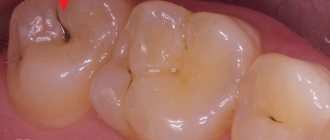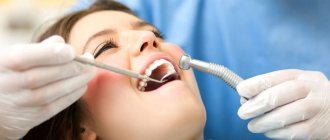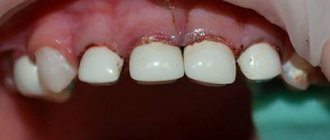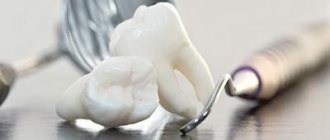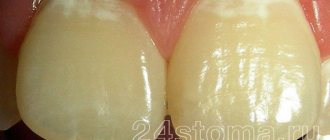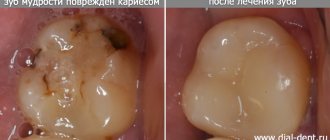Pulpitis of the tooth
| Dental pulpitis develops in the later stages of caries, when the inflammatory process reaches the soft tissues, which are called pulp. The pulp itself consists of a vascular bundle, connective tissue and nerves. It is the nerves that give pain signals when pathology develops and occurs in the root canal and pulp chamber. The disease is characterized by severe and unpleasant pain, which is especially disturbing at night. Patients also complain of pain reactions that occur when taking hot and cold food or drink. |
How to distinguish caries from pulpitis yourself?
A professional dentist can accurately diagnose pulpitis and caries. But the patient will be able to distinguish these diseases independently, based on his own feelings:
Caries causes pain only if a person eats something sweet or cold, and the discomfort quickly passes;- Pulpitis is characterized by severe pain that lasts 10 minutes or more;
- Painful sensations during caries occur only when eating certain foods;
- Pain from pulpitis appears suddenly and for no apparent reason.
Note: distinguishing caries from pulpitis will help not only the nature of the pain, but also the time of its onset. If a patient suddenly wakes up at night from severe toothache, there is every reason to suspect pulpitis. Since caries does not affect the nerve, pain associated with this disease does not occur at night.
Symptoms and causes of pulpitis
Depending on the clinical picture, pulpitis can be acute or chronic. The acute form usually develops into a chronic form, and then the sick person simply does not pay attention to periodic pain. This condition is dangerous because periodontitis can begin, in which periodontal inflammation occurs. The reasons for the formation of pulpitis are the following factors:
Caries
The disease leads to the gradual destruction of hard dental tissues and pathogenic microorganisms enter the pulp chamber, leading to pulpitis
Trauma or bruise of a tooth
Trauma or bruise of a tooth can also lead to the development of pulpitis
Complications of certain infectious diseases
When pulpitis forms in the pulp chamber. In such a situation, pathogenic microorganisms enter the pulp from a cyst or periodontal pocket
Due to incorrect previous medical procedures
In particular, pulpitis often appears after incorrectly performed dental canal filling technology.
What is caries
Dental caries is a severe, pathological process that occurs in the hard tissues of the tooth. The source of caries is the destructive effect of microorganisms on the hard tissues of the molar. First there is deterioration of the enamel, and then of the dentin. Subsequently, with further damage to the pulp chamber, which occurs under the influence of the acids that these bacteria secrete during their life cycle. Types of caries:
- Coronal caries - This type usually occurs on the chewing surfaces of teeth or between teeth.
- Caries in the stage of darkening of the enamel.
- Caries between teeth (lateral surfaces) - with this type of caries, two molars adjacent to each other are often affected at once.
Diagnosis and treatment of pulpitis
You can contact the NIKADENT dental clinic and we will provide comprehensive treatment for pulpitis. First of all, an examination of the oral cavity is carried out and an x-ray diagnosis is prescribed. On a targeted X-ray of the tooth, the presence of a pathological focus can be clearly seen. Treatment steps include:
- Anesthesia;
- Elimination of areas of the tooth affected by caries;
- Removal of infected dentin from the dental cavity;
- Nerve removal;
- If necessary, placing antiseptics into the tooth cavity and closing the cavity with a temporary filling;
- Mechanical and medicinal treatment of canals with further filling;
- Installation of a seal.
After all procedures, X-ray control is performed. We guarantee that we will provide the most effective treatment of pulpitis with subsequent tooth filling. How to prevent the appearance of pulpitis? First of all, you need to carefully monitor the condition of your teeth, carry out daily oral hygiene by cleaning your teeth with floss, irrigators, rinses, toothbrushes and pastes.
Methods for diagnosing caries and pulpitis
Diagnosis of caries:
- Vital coloring. The tooth is cleaned of plaque, isolated from saliva, dried and a special dye is applied. After washing, you can see which tissues are affected by caries - they remain stained with different intensities.
- X-ray examination. X-rays are also used to determine the area of damage
- Thermal tests - short-term exposure of a suspicious area with cold or hot water to distinguish caries from pulpitis.
Diagnosis of pulpitis:
- Electroodontodiagnosis is an analysis of the tooth’s reaction to electricity; this will show the functionality of the nervous system.
- X-ray studies.
You should remember that dental prophylaxis and good hygiene will prevent the occurrence of caries and pulpitis. At the first symptoms, you should make an appointment with a dentist and get a diagnosis. We hope this article helped you. For more information, please visit the dentistry link.
Prices for services
| Name | Price |
| Consultation | For free |
| Treatment of pulpitis and periodontitis | |
| Mechanical and medicinal treatment of one canal | 1,100 rub. |
| Repeated mechanical and medicinal treatment of one canal | 500 rub. |
| Unsealing one root canal | 1,100 rub. |
| Filling one canal using vertical condensation method | 1,300 rub. |
| Filling one canal using lateral condensation method | 1,150 rub. |
| Temporary filling of one canal with medicinal paste | 500 rub. |
| Installation of intrachannel fiberglass pin | 1,450 rub. |
| Temporary chemical filling | 400 rub. |
| Light temporary filling | 450 rub. |
Pulpitis in adults
Due to the higher sensitivity of blood vessels, pulpitis in adults can be recognized already when the first pain symptoms appear. Do not delay consulting your doctor. Even if the cause of the pain turns out to be something else, it is better to eliminate it now. It will only get worse. There is no need to take painkillers and try to cope on your own. In severe cases, pulpitis can develop into periodontitis, which can lead to tooth loss.
There is such a form of the disease as chronic pulpitis. It comes in several types, depending on the nature of the damage to the pulp tissue. Symptoms include aching or sudden severe pain, a painful reaction to hot or cold temperatures, discoloration of enamel, and an unpleasant odor.
Chronic pulpitis requires immediate treatment. The risk of progression to a more serious disease, periodontitis, threatens tooth loss. Indeed, in this case, inflammation spreads to the root system.
What is periodontitis?
| Periodontitis, like pulpitis, is a complication that accompanies the development of caries. The disease may appear due to injury or improper dental treatment. With periodontitis, the inflammatory process moves to the periodontal area, which is a narrow space of connective tissue between the bone socket and the tooth itself. According to the clinical course, the disease can be acute or chronic. Acute periodontitis is characterized by sharp pain, sensitivity to cold or hot, and swelling of the gums. Flux forms in the area where gum tissue is damaged. The chronic form is often asymptomatic, but this is where the danger lies, since the inflammatory process begins to actively develop deep in the tissues. |
There are the following forms of chronic periodontitis:
- Granulomatous periodontitis;
- Fibrous;
- Granulating.
It is important to note that periodontitis is a dangerous disease for health and cannot be cured on its own. You should definitely contact your dentist in order to diagnose and eliminate it on time.
Main Differences
The main difference between caries and pulpitis is the depth of penetration of the inflammatory process into the tooth tissue.
It is not difficult to determine the difference between caries and pulpitis. At the initial stage of tooth damage, a small stain appears on its surface. This pathology is called caries. In the future, if you do not treat your teeth, the inflammation will move deeper into the tooth, affecting more and more areas of tissue.
Deep caries that has reached the nerve is pulpitis. In this case, not only the tooth tissue is destroyed, but also the nerve, so in most cases it is removed, and the canals are sealed to prevent the resumption of inflammation in the future.
Diagnosis and treatment of periodontitis
| Our dental clinic "NIKADENT" provides modern and effective treatment of periodontitis. First of all, when visiting a doctor, the oral cavity is examined and a diagnosis is prescribed. An accurate diagnosis can be obtained through the use of X-ray examination. Based on the image obtained, the doctor determines the type and nature of the pathology, the area of formation of the lesion, and the condition of the tooth. The treatment is complex and consists of the following medical procedures: |
1. Preparation of tooth tissues and unfilling of the dental canal. The doctor uses a bur to open the tooth cavity and, if there is a history of caries, removes the affected dentin;
2. Obturation of all canals in the tooth. It is impossible to do without thorough cleansing and antiseptic treatment of the root, so our dentists use special antiseptic pastes for this purpose;
3. Installation of a temporary filling. After obturation, the dental canals are processed and antibacterial substances are placed in them, which kill all pathogenic microorganisms;
4. Installation of a permanent filling, which is placed after eliminating the pathological focus. At the last stage, the tooth is restored and, if necessary, roots are pinned.
Treatment of periodontitis and pulpitis cannot be delayed. Be sure to contact your dentist on time. Our NIKADENT clinic guarantees its patients the highest quality of dental services.
Symptoms of pulpitis
When it becomes clear that this is tooth pulpitis, it is worth understanding the stages of its development and symptoms. How does this disease begin? This is evidenced by increased sensitivity from food and drinks of cold and hot temperatures - pain occurs that lasts 10-15 minutes. And if such sensitivity during caries passes quickly enough, then inflammation of the pulp is characterized by prolonged pain.
As the process progresses, the pain intensifies. At the same time, the general condition worsens, the head begins to hurt, weakness occurs, and the temperature rises. These are just the main symptoms, to which sleep and mood disturbances may be added. Subsequently, attacks of pain can radiate to the shoulder, head, and neck.
Each patient will have an individual set of symptoms, expressed to a greater or lesser extent. It depends on the level of tissue damage and general health.
Diagnosis of dental pulpitis
How is dental pulpitis diagnosed? The doctor conducts an examination and examines carious areas, if any. Next, there are several ways to check the condition of the pulp and assess the extent of its damage.
The condition of nerve endings can be examined using electric current. The pulp can be examined using an x-ray. Testing the condition of the tissues with cold and heat can also help.
When the doctor determines the presence and causes of pulpitis and pain when biting, you will need to choose the appropriate treatment. Let's consider the treatment methods further.
Therapeutic treatment of cysts
If the size of the cyst does not exceed 8 millimeters, drug treatment is necessary. The entire treatment process takes place in several stages:
Opening of the causative tooth, instrumental and thorough medicinal treatment of the canals. The tooth canals are filled with medicinal paste, which has antimicrobial and anti-inflammatory effects. Periodically, the medicinal paste must be changed, so the tooth is opened again, and the cavity is filled with a new portion of medicinal paste. The number of repetitions depends on how successful the treatment is. The doctor monitors the condition of the cyst using x-rays.
- If the treatment is successful, as evidenced by a decrease in the size of the cyst, the dentist decides to permanently fill the canals and takes measures to restore the tooth.
- The process of further reduction of the cyst and regeneration of bone tissue is monitored for two years. To do this, it is necessary to take a photo every few months, since if the treatment is insufficiently effective, timely measures must be taken.
The only drawback of conservative therapy is its duration. During treatment, regular visits to the dentist are necessary, and further observation by the attending physician is necessary.
Gum diseases
Pulpitis
Pulpitis is an inflammatory disease of the soft tissues of the tooth, of an infectious nature, which is the most common consequence of untimely or poor-quality treatment of carious lesions, characterized by acute pain and a sharp reaction to temperature stimuli.
Pulpitis is not so much an independent disease as a consequence of improper treatment of dental diseases or lack of treatment as such. The mechanism of development of the disease is simple: in the presence of carious lesions left unattended, the destruction of hard tooth tissues can reach the root pulp, as a result of which microorganisms and their metabolic products begin to penetrate into the vascular bundle located in the center of the tooth. The ingress of pathogenic agents is accompanied by a response accompanied by acute pain, a sharp, time-long reaction to cold or hot - this is inflammation. In addition to caries, pulpitis can be caused by tooth trauma - loss of part of the tooth or crown, fracture, crack.
Symptoms of pulpitis are varied and depend on the form of the disease. There are acute and chronic forms of the disease. Acute pulpitis is characterized by periodically occurring pain in the tooth, occurring suddenly and disappearing on its own. Most often, pain occurs in the evening and at night. At the initial stages of the development of the disease, pulpitis may not bother the patient much, but over time, attacks of pain become more frequent and intensified, the pain becomes pulsating in nature and is expressed with greater intensity. Sometimes the pain radiates to the jaw, ear, or nearby areas, which can cause a migraine or headache attack. Subsequently, the pain becomes unbearable, excruciating and cannot be relieved with painkillers.
Chronic pulpitis manifests itself somewhat differently. This disease in its chronic form makes itself felt with any thermal changes - painful sensations occur when the temperature changes, for example, when moving from a cold room to a warm one and vice versa, eating very cold or very hot. As the thermal factor is eliminated, the pain gradually subsides. Spontaneously occurring causeless pain is not typical for chronic pulpitis.
Treatment of pulpitis involves removing the pulp and installing a filling on the damaged tooth. If pulpitis is not treated, a number of complications and consequences may develop. The most common include: periodontitis, periostitis; osteomyelitis, etc.
Why is a dental cyst dangerous? Consequences of the disease
A cyst that is not detected in time grows, which leads to the destruction of bone tissue and its replacement with connective tissue formations. As a rule, at this stage complications appear that lead to tooth loss. Possible complications with a dental cyst:
- Purulent inflammation of the cyst.
- Melting of the jaw bone due to cyst growth.
- Inflammation of the lymph nodes.
- The appearance of chronic sinusitis due to the growth of a cyst into the maxillary sinus.
- The appearance of osteomyelitis or periostitis.
- Formation of an abscess on the gum or cheek.
- Formation of phlegmon of the neck due to prolonged purulent inflammation.
- The development of sepsis - blood poisoning.
- Spontaneous fracture of the jaw, which appears due to the growth of the cyst and thinning of the bone.
Methods for treating diseases
When a caries cavity forms, the dentist cleans out the tissues destroyed under the influence of the disease. After this, the cavity is disinfected and a filling is installed.
Treatment of pulpitis involves preliminary opening of the tooth canal. The non-viable area of the pulp is removed. After this, the tooth’s root canals are disinfected and filled. There are several filling methods, and a specialist selects the optimal one.
Prevention of caries and pulpitis allows you to maintain healthy teeth. Regular examinations allow you to identify the early stages of caries and prevent the disease from progressing. If you choose dentistry, then you should study the dentistry website.
Caries and pulpitis: differences, symptoms and causes
Caries and pulpitis are the most common diagnoses made by dentists. 95% of the population suffers from these diseases in one form or another. Pulpitis and caries, being very closely related to each other, affect different parts of the tooth and often the cause of pulpitis is precisely advanced caries.
How to recognize that caries has gone too far and can cause complications? What are the causes of caries and pulpitis?
How to recognize caries.
At the very first stage of the disease - the stain stage - a soft plaque appears on the surface of the tooth. The microbes living in it form organic acids, which lead to demineralization of the enamel. Visually, such a spot differs from healthy tissue in color. It may be brownish, yellowish or chalky. At this stage, the patient does not experience pain, but the reason for contacting a doctor should be a change in the color of the enamel. Only a dentist can definitively diagnose caries at this stage.
When destructive processes intensify, the tooth surface becomes rough . Mechanical pressure or contact with too cold, sweet, hot or sour food causes the tooth to hurt. If such symptoms occur, it is necessary to begin treatment as quickly as possible. At this stage, it usually consists of grinding off the affected areas and restoring the mineral composition of the enamel.
The destructive process affects not only the surface enamel, but also dentin. A visual sign of the disease is a clearly visible tooth lesion. The patient experiences intense and frequent pain , not necessarily after exposure to aggressive factors, such as cold food. Treatment consists of cleaning the affected tissue and installing a filling.
At this stage, the tooth has a fairly large cavity . Touching this area causes pain. Bad breath may occur. If the disease takes this form, treatment should follow immediately. If treatment is not promptly addressed, dental caries will progress to a complicated stage, accompanied by pulpitis. Very often, the inflammation of the nerve during pulpitis is so severe that the nerve has to be removed
Causes of caries
Poor oral hygiene
Insufficient dental care, irregular brushing and irregular visits to the dentist are the main factors in the development of caries. Accumulations of soft microbial plaque, hard tartar and food debris with poor hygiene inevitably lead to disastrous consequences. Brushing your teeth for 2 minutes after eating with a properly selected toothpaste and brush, as well as promptly removing tartar, is extremely important to prevent dental problems in the future.
Poor nutrition.
Lack of vitamins, an abundance of food containing sugar, and a lack of raw vegetables and fruits in the diet are one of the main reasons for the development of caries. The rural population is much less susceptible to caries than the urban population due to the consumption of natural products. Natural food, the correct ratio of proteins, fats and carbohydrates provide higher resistance to dental caries. In addition, an important factor in the issue of caries occurrence is the low content of calcium, fluorine and phosphorus in drinking water.
General state of human health.
Various diseases suffered in childhood (tuberculosis, rickets, etc.) can disrupt the proper formation of dental tissues and make them more susceptible to caries in the future. Diseases of the gastrointestinal tract, hereditary predisposition and weak immunity of the body also place a person at risk.
Social factors.
It should also be noted that there are a number of occupational hazards that affect tooth enamel. The production of acids and alkalis, waste from the confectionery industry, and industrial waste associated with salts of heavy metals increase the prevalence and intensity of such diseases as dental caries.
Stage of pulpitis
Caries, if it is not treated on time, turns into pulpitis. The difference between caries and pulpitis is that during caries, only the hard tissues of the tooth are destroyed without concomitant inflammation of the neurovascular bundle (pulp). When the destruction process goes very deep and the destructive effect penetrates into the tooth pulp, its inflammation occurs, which is accompanied by acute or chronic aching pain. Pulpitis, if it is also not treated in time, turns into periodontitis - a disease in which inflammation already extends beyond the boundaries of the tooth. In this case, purulent sacs form in the area of the apex of the roots of the diseased tooth, and fistulas form on the gums.
It is not always caries that gives impetus to the development of pulpitis. In some cases, the tooth breaks due to mechanical stress, the enamel falls off, and again a “gate” for infection is formed. Sometimes tooth enamel is damaged by chemicals that corrode it. The most common cause of the disease is a coccal infection, or more precisely streptococcus. At first, it is the area of the soft tissues of the tooth that is adjacent to the carious cavity that becomes inflamed. And then the inflammatory process goes deep into the tooth.
Treatment of caries and pulpitis
The sooner treatment is started, the better. A professional dentist is able to determine the degree of development of caries, including in the early stages, and choose the appropriate and most effective method of treatment. To treat caries in the spot stage, it is enough to restore a sufficient amount of mineral using a special solution. For superficial, medium and deep caries, the carious cavity is treated with subsequent filling. For the deepest caries, medicated pads containing calcium hydroxide are used, which promotes the formation of “secondary” dentin, i.e. allows for additional protection for the integrity of the tooth nerve.
Both caries and pulpitis are curable and after treatment the teeth fully perform their functions. Modern treatment methods make it possible to treat teeth with both caries and pulpitis, preserving the nerve. But the effectiveness of such treatment directly depends on the patient himself and the stage at which he turned to the dentist.
Treatment
Previously, it was possible to get rid of pulpitis, or periodontitis, only by removing the tooth, but the advent of such methods as filling the dental canals, or, as “people” used to call it, “filling,” makes it possible to save the tooth.
- The first stage of treatment is an x-ray. It is carried out in order to study the structural features of the tooth, such as the depth of the dental canals, the length of the nerves, etc. Next, anesthesia is performed; you can refuse it, but this is not recommended, since without it the patient experiences severe pain. Next, the doctor performs an “opening” of the tooth and removes the pulp along with the tooth roots. It is very important to completely remove the tooth root and its small remains, as well as dental tissue shavings, for a high-quality filling.
- The next stage of treatment is filling. To begin with, it is important to completely sterilize the treatment area to avoid infection from outside. This is followed by filling the dental canals with special pastes. An important part of the doctor’s work is to tightly fill all treatment areas; if there is a small area of emptiness, a new infection will develop and lead to re-inflammation.
Next, the removed part of the tooth is built up. Thanks to the availability of modern materials, a partially destroyed tooth can be restored. In this case, the color and shape will be the same as before the procedure. Modern treatment is good because it is painless thanks to anesthesia, takes 40-60 minutes and does not require repetition in the future.
Advantages of dental canal filling over removal of the entire tooth:
- filling helps avoid damage to the gums or bone;
- installation of a “false” tooth is not required;
- Filling makes it possible to save teeth that would seem impossible to restore.
You can make an appointment with a specialist on any issue by phone+7
Complications of pericoronitis
Purulent pericoronitis:
- Constant pain that intensifies when chewing;
- Pain radiating to the ear and temporal region;
- Increased body temperature up to 37.2 - 37.5°C;
- Mouth opening is limited and painful, which intensifies with the development of inflammation;
- The submandibular lymph nodes are enlarged and painful when pressed;
- When pressing on the hood, purulent contents are released from under it, causing sharp pain.
Acute pericoronitis can become chronic, when the inflammatory phenomena do not completely subside and exacerbations periodically occur.
Retromolar periostitis.
Occurs as a complication of purulent pericoronitis. The disease is characterized by clinical symptoms of purulent pericoronitis, but more pronounced.
- The pain intensifies;
- The general condition is disturbed, weakness and weakness appear;
- Body temperature rises to 38-38.5°C;
- Chewing food becomes impossible;
- Sleep is disturbed;
- The patient is pale, there is pronounced tissue swelling in the posterior part of the submandibular and lower part of the buccal region;
- The submandibular lymph nodes are enlarged and painful;
- When you press on the hood and surrounding tissues, a sharp pain occurs.
source site. www.dentalmir.ru
The best dentists in Sarov, where to treat teeth in Sarov
What tools and equipment are used in our clinic?
First and most important
when treating tooth canals and treating pulpitis, this is an opportunity to quickly and effectively conduct an X-ray examination (radiovisiography). It is necessary for: making a correct diagnosis, determining the length and location of the canals, and monitoring the quality of their filling.
The advantage of a radiovisiograph is that the radiation exposure to the patient is 10–20 times less than when using a conventional X-ray machine.
Second
, the presence of an apex locator allows the doctor to know exactly in which part of the canal the instrument is located.
Third
, the presence of an endodontic motor allows you to work with advanced nickel-titanium instruments to expand and taper the canal. This allows you to efficiently clean and seal the canals.
Fourth
, the presence of optics allows the doctor to see the hidden mouths of the canals.
Fifth
, our clinic uses the latest advances in dentistry in canal treatment - three-dimensional obturation of root canals with hot thermoplasticized gutta-percha. During heating, gutta-percha becomes very plastic, due to which the tooth canal system is tightly sealed. This material is introduced on a special carrier made of a denser, modified gutta-percha - Gutta Core, preheated in a special oven. The tightness of the material virtually eliminates the risk of developing an infection in the tooth. Gutta-percha does not dissolve over time and does not irritate the tissue surrounding the tooth.
This method is very effective, it involves sealing and filling the entire system of lateral tubules, but it requires a highly qualified doctor and considerable financial and time costs.
Signs of acute periodontitis
Symptoms of acute periodontitis are always pronounced. Among them:
- Acute aching pain, the intensity of which is constantly increasing;
- Pain increases when trying to eat;
- If treatment for periodontitis was not started on time, attacks of pain will appear more and more often, and the intervals between them will become shorter and shorter;
Against the background of intense pain, a person cannot eat, speak, sleep, and may develop an elevated temperature. In the acute form of periodontitis, significant tumors and swelling often appear in the area of the diseased tooth. The cheek may also swell. This occurs due to the active accumulation of pus in the soft tissues of the oral cavity.



